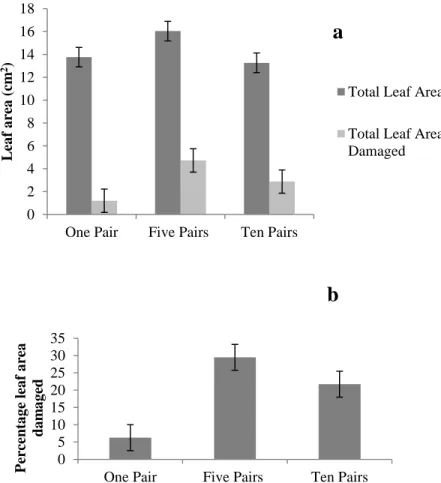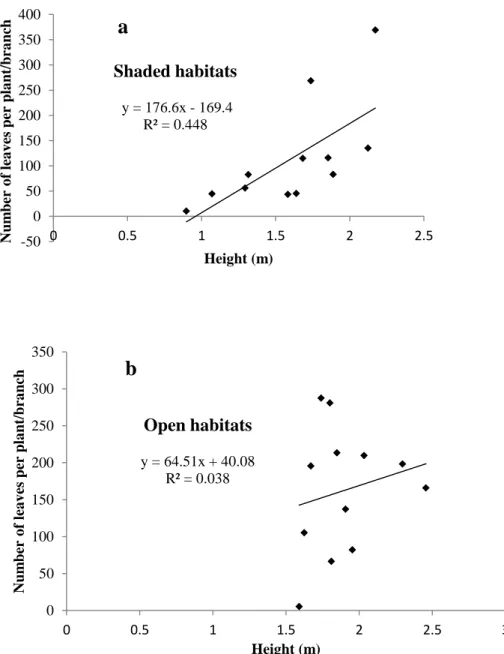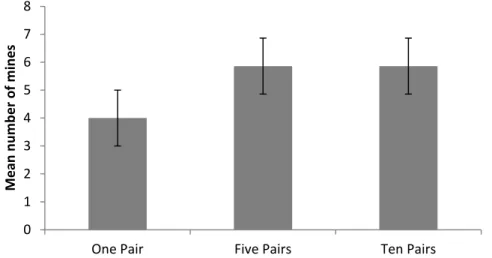Both plant/branch height and the number of leaves increased between September and March, and plants in the open habitats were taller and had The mean number of mines, both total and relative to available leaves, was highest in March, and was higher in the shaded habitats compared to the open habitats. The average number of mines per damaged leaf was slightly higher in December compared to the other seasons, and was also higher in the open than the shaded habitats.
General introduction
- Invasive alien plants in South Africa
- Control of invasive alien plants in South Africa
- Chromolaena odorata in South Africa
- Description of C. odorata
- Ecology of C. odorata
- Harmful impacts of C. odorata
- Control of C. odorata
- Leaf-mining insects and their ecology
- Calycomyza eupatorivora, a leaf-mining agent for C. odorata
- Aims and objectives of the study
The form of chromolena invading southern Africa is morphologically different from that invading Asia and West Africa (Zachariades et al., 2004). In the Old World, Chromolaena is an invasive transformer species, at least in part because it has no natural enemies (Richardson et al., 2000). Pareuchaetes pseudoinsulata Rego Barros (Lepidoptera: Arctiidae), leafmining moth, Pareuchaetes insulata Walker, second leafmining moth, Cecidochares connexa Macquart (Diptera: Tephritidae), stemmining fly, and Calycomyza eupatorivora Spencer (Diptera: Agromy zidae), a fly with leaf-mining larvae (Zachariades et al., 1999).
Oviposition and larval development patterns resulting from different densities of
- Introduction
- Materials and methods
- Plants and insect cultures
- Experimental design and data collection
- Data analysis
- Results
- Relationship between leaf area and leaf length/width
- Leaf area damaged by C. eupatorivora larvae
- Number of leaves damaged and mines per damaged leaf
- Leaf quality in relation to usage by C. eupatorivora
- Discussion
After about 5 days, most larvae had pupated and they were then counted and placed in emergence boxes. The plants were then exposed to 1, 5, or 10 pairs of newly mated flies and three replicates were performed for each of the three fly densities. For each leaf, the estimated damaged area (cm2) was calculated by multiplying this proportion by the calculated area of the leaf.
The total leaf area available on the plant and the total damaged leaf area were then calculated as the sum of the total and damaged leaf area of each leaf. It was assumed that the number of mines initiated reflected the female's preference for oviposition, i.e. larvae were crushed in mines as soon as mines appeared; This assumes that the initiated leaf mines do not significantly affect the quality of the leaf.
The maximum percentage of leaf area damaged during the trials was 37.5% for one of the trials involving five pairs of flies. odorata plants available and damaged after exposure to one, five and ten pairs of C. eupatorivora flies in the laboratory. a) Mean (± 1 SE) leaf area available and leaf area damaged per plant; (b) Mean (± 1 SE) percent leaf area damaged per plant. This indicates that leaves from the same plant differ in terms of quality, toughness or nutritional composition. These results showed that five pairs of flies caused more damage than one pair, but that 10 pairs did not cause more damage than five pairs, and that the flies rarely damaged more than 30% of the leaves.
NSC content can vary between leaves of the same plants because some leaves are more mature (older) than others. For chromolaena, young leaves at the top of the plant will have higher NSC content than those at the bottom of the plant. This can vary depending on how the situation of the plants (eg growth phase, light intensity) can affect leaf quality.

Abundance of C. eupatorivora larval mines on C. odorata in the field
Introduction
Studies of other systems have shown that the fitness of a leaf to develop progeny of the fly can change with leaf age due to changes in the chemical or physical properties of that leaf (Raupp and Denno, 1983; King et al., 1998). . Similarly, leaves growing in shaded areas are physically softer and usually contain more nitrogen and moisture than those in full sun (Raupp and Denno, 1983; Raupp, 1985; Denno et al., 1990).
Materials and methods
- Experimental design and data collection
- Data analysis
32 plants/branch were marked with an individually numbered plastic tag and the following data were recorded at each sampling interval: plant/branch height (to the tip of the tallest living stem) from the ground (for large sprawling plants measured from the point on the ground directly below the base of the selected branch); total number of leaves (>0.5cm long); number of mined leaves;. Mine are also recorded as "old" or "young"; the "young" mines are those over which the leaf epidermis still looks white and fresh and may contain live larvae, and "old" mines are those which developed a few weeks ago, over which the epidermis has turned brown or peeled away. . The same marked individual plants/branches were measured at each of the four sampling occasions.
The data obtained were analyzed using GENSTAT, Repeated Measures Analysis of Variance (Generalized Linear Model) to account for the fact that the same plants were sampled over four seasons. Season was treated as consecutive time data because the same chromolaena plants were sampled repeatedly over four seasons. Post Hoc tests, namely least significant difference (LSD) tests, were performed to determine if there were significant differences between the three sites, two habitats and four seasons with respect to the recorded variables.
The 33 damaged leaves were calculated by dividing the total number of mines counted on the plant/branch by the number of damaged leaves on the same plant/branch, where a damaged leaf was a leaf with at least one C initiated. The average number of mines relative to available leaves was calculated by dividing the total number of mines by the number of leaves per plant/branch. Minimum larval mortality was calculated by dividing the number of old, incomplete mines (i.e. the larva did not complete development and thus apparently died) by the total number of mines.
Regression analysis was performed to determine the strength of the relationship between plant height and leaf number.
Results
- Plant/branch height
- Number of leaves
- Relationship between number of leaves per plant/branch and plant height
- Numbers of leaf mines per plant/branch
- Mean proportion of mines in relation to leaves available
- Mean number of mines per damaged leaf
- Mean proportional larval mortality („minimum‟)
- Overall levels of mining
The average number of leaves per plant/branch was low in spring, September 2009, but increased as the next season, summer (December), approached and was highest in March 2010. Number of leaves and height showed a significant positive linear relationship, although the relationship was slightly stronger (R for the shaded habitats, but weaker (R for the open habitats) (Fig. 3.3).The average number of mines (only for both all mines and complete mines) per plant/branch was highest in March and very low in December.
The number of both all mines and complete mines per plant/branch was significantly higher at site 1 than at the other two sites. The average proportion of mines in relation to available leaves per plant/branch showed a similar pattern to the total number of mines and the number of complete mines. At all three sites, the average number of mines relative to available leaves was always lower in the open habitats (Fig. 3.5d).
There was a marked increase in the average number of mines per damaged leaf, calculated on the basis of plant/branch, from approx. 1.2 mines per leaf in September at 1.7 mines per magazine in December, with approx. 1.4 mines per magazine in March and July. (Fig. 3.6a). Overall, the difference in mines per damaged leaf between the four seasons significantly (F p. < 0.001), but March and July were not significantly different from each other. Average (± 1 SE) number of mines per damaged leaf (a) between the four seasons, (b) in shaded and open habitats and (c) between the three sites.
Mean (± 1 SE) proportional mortality of larvae („minimum‟) between (a) four seasons, (b) shaded and open habitats and (c) three sites.

Discussion
- Number of leaves and height of chromolaena plants
- Relationship between number of leaves and plant/branch height
- Overall number of mines (total and complete) and number of mines in relation to
- Mean number of mines per damaged leaf
- Mean proportional larval mortality („minimum‟)
Plants in the shaded site (under Eucalyptus) contributed more to the difference in leaf number and height among the three sites; thus, a significant interaction between habitat and location, but at sites 1 and 2 outdoor plants were taller and had more leaves. In this study, there was also a positive relationship between leaf number and height, although this was fairly strong only in shaded habitats and weak in open habitats. This is probably because the existing branches on the plants generally do not grow much longer even in the new season.
The total number of mines and the number of mines in relation to available leaves show a similar pattern to each other. However, the number of mines in relation to the number of leaves available was significantly higher in the shade. Both the total number of mines and the mean number of mines relative to available leaves were lowest at site 3.
There was a significant interaction between habitat and season, indicating that the number of mines relative to available leaves in both habitats did not show a constant pattern across the four seasons. Although at all three sites, the number of mines relative to available leaves appeared to be slightly higher in the shaded habitat, there is a significant interaction between habitat and area meaning that the pattern is not consistent across the three countries. Compared between the two habitats, the number of damaged leaf mines was slightly higher in the open, and this is probably because there was less suitable leaf in relation to the number of eggs laid.
There were significant interactions in the mean number of mines per damaged leaf between season and habitat, and season and site, indicating that the mean number of mines across the four seasons did not vary consistently between habitats or sites.
General discussion and conclusions
In: Proceedings of the Seventh International Workshop on Biological Control and Management of Chromolaena odorata and Mikania micrantha, Taiwan, 12-15 September 2006, Po-Yung Lai, G.V.P. Past and present biological control initiatives of Lantana camara (Verbenaceae) in South Africa. In: Proceedings of the Fourth International Workshop on the Biological Control and Management of Chromolaena odorata, P.
The history and prospects of the biological control of Chromolaena odorata (Conpositae) by Pareuchaetes pseudoinsulata Rego Barros and allies (Lepidoptera: Arctiidae). Reproduction of a pantropical weed: Chromolaena odorata (L.) R. Review of the status and integrated control of the invasive alien, Chromolaena odorata, in South Africa. De Foresta (ed) Proceedings of the Third International Workshop on Biological Control and Management of Chromolaena odorata.
Invasive alien trees and water resources in South Africa: case studies of management costs and benefits. Costs and benefits of biological control of invasive alien plants: case studies from South Africa. In: Proceedings of the Fifth International Workshop on Biological Control and Management of Chromolaena odorata, C.
Effect of the biological control agent Hydrellia pakistanae (Diptera: Ephydridae) on the submerged aquatic weed Hydrilla verticillata (Hydrocharitaceae). In: Proceedings of Fifth International Workshop on Biological Control and Management of Chromolaena odorata, Durban, South Africa, October 2000, C. South African program on biological control of Chromolaena odorata (L.) King & Robinson (Asteraceae) using insects .
